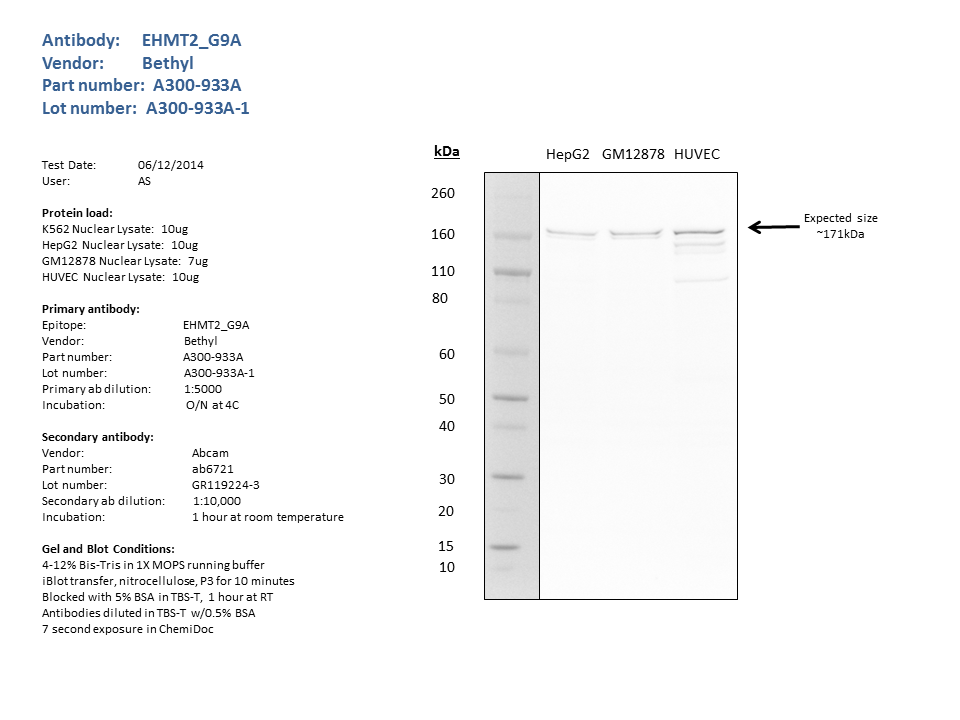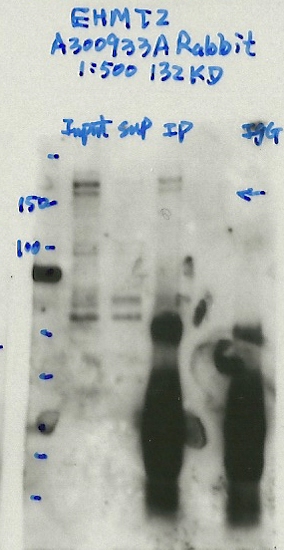ENCAB282XQE
Alternate accession: ENCAB805FRK
Antibody against Homo sapiens EHMT2
Homo sapiens
HepG2, GM12878, endothelial cell of umbilical vein, A549, K562
characterized to standards with exemption
- Status
- released
- Source (vendor)
- Bethyl Labs
- Product ID
- A300-933A
- Lot ID
- 1
- Characterized targets
- EHMT2 (Homo sapiens)
- Host
- rabbit
- Clonality
- polyclonal
- Antigen description
- H3K9 methyltransferase G9a
- Aliases
- bradley-bernstein:PchAb 255, michael-snyder:AS-1566
- External resources
Characterizations
EHMT2 (Homo sapiens)
Method: ChIP-seq comparison
exempt from standards
- Caption
- This validation relies on the use of antibodies to a histone lysine methyltransferase (EHMT2-G9a) and a chromatin regulator (CBX3) in HepG2 cells, and the demonstration that highly similar patterns of enrichment are obtained with each antibody. The first track shown used an antibody to EHMT2 (PchAb 255, ENCAB282XQE), and the second track shown used an antibody to CBX3 submitted for characterization to Encode standards (PchAb 362, ENCAB000AHR).
- Submitter comment
- SAV7
- Reviewer comment
- Not compliant due to low genome-wide correlation (Correlation at 0.7147). Must be 0.8 or greater. However, this decision was overridden by Dr. Peggy Farnham (chair of the ENCODE antibody review committee) for the following reason ".. they were comparing datasets from EHMT2 and CBX3. Although I would expect the patterns to be quite similar, they will NOT be identical as CBX3 will not necessarily bind to all EHMT2 positions. Based on the visual inspection, the tracks (in combination with the primary characterization) do support the conclusion that the EHMT2 antibody is most likely correct. Therefore, assuming the datasets passed IDR, I would approve release with the same statement as before."
- Submitted by
- Nina Farrell
- Lab
- Bradley Bernstein, Broad
- Grant
- U54HG006991
- Download
- EHMT2-G9a PchAb 255 SAV.pdf
EHMT2 (Homo sapiens)
HepG2GM12878endothelial cell of umbilical veinA549
compliant
- Caption
- Nuclear lysates from K562 (10ug), HepG2 (10ug), GM12878 (7ug), HUVEC (10ug), were loaded into a 4-12% Bis-Tris gel in 1X MES running buffer. After separation, the samples were transferred to a nitrocellulose membrane using the iblot system. Membrane was blocked for an hour in room temperature, with 5% BSA in TBS-T and blotted with primary antibody in the appropriate concentration over night at 4c. Membrane was washed and blotted with secondary HRP-conjugated antibody. Detection was made with Optiblot ECL Detect Kit (ab133406) for 2 min. A single band around the expected size was detected.
- Submitter comment
- The antibody review board exempted A549 data from primary characterization requirement based on the quality of the ChIP of the two replicates and the other cell lines 03-05-2018
- Reviewer comment
- The expected size is ~132 kDa but runs near 165 kDa, which corresponds to the 165 kDa G9a-L isoform.
- Submitted by
- Noam Shoresh
- Lab
- Bradley Bernstein, Broad
- Grant
- U54HG006991
EHMT2 (Homo sapiens)
K562
compliant
- Caption
- Immunoprecipitation was performed on nuclear extracts from the cell line: K562, using the antibody A300-933A. The blot shows western blot analysis of input, flowthrough, immunoprecipitate and mock immunoprecipitate using IgG.Molecular Weight: 132.370
- Reviewer comment
- The expected size is ~132 kDa but runs near 165 kDa, which corresponds to the 165 kDa G9a-L isoform.
- Submitted by
- Denis Salins
- Lab
- Michael Snyder, Stanford
- Grant
- U54HG006996

